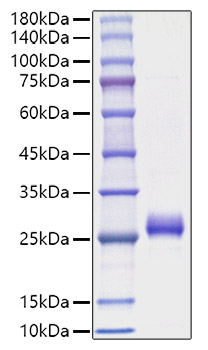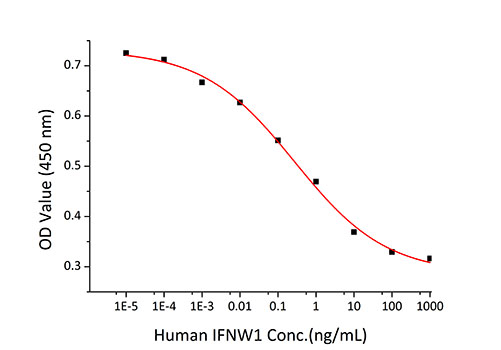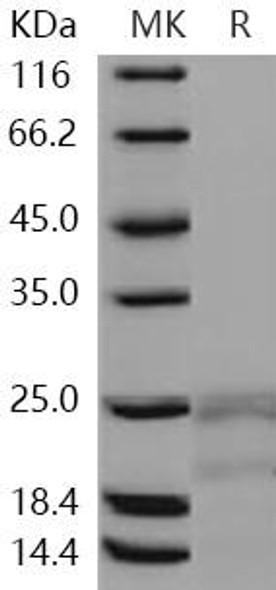Description
Recombinant Human Interferon omega-1/IFNW1 Protein
The Recombinant Human Interferon omega-1/IFNW1 Protein is a biologically active recombinant protein that plays a significant role in various cellular processes and signaling pathways in human biology. This protein is widely employed in immunological research, cell biology studies, protein-protein interaction analyses, and therapeutic development, providing researchers with a reliable tool for investigating Interferon omega-1/IFNW1 function and its implications in health and disease.
This product (SKU: RPCB1248) is produced using HEK293 cells and features a C-6His tag for convenient detection and purification. The protein exhibits a calculated molecular weight of 20.88 kDa with an observed molecular weight of 25-30 kDa under denaturing conditions, achieving ≥ 95 % as determined by SDS-PAGE.. Functional bioactivity has been validated through rigorous quality control assays, confirming its suitability for demanding research applications.
Key Features
| High Purity by Affinity Chromatography | |
| Mammalian & Bacterial Expression Systems | |
| High lot-to-lot consistency via strict QC |
| Product Name: | Recombinant Human Interferon omega-1/IFNW1 Protein |
| SKU: | RPCB1248 |
| Size: | 10 μg , 20 μg , 50 μg , 100 μg |
| Reactivity: | Human |
| Synonyms: | Interferon omega-1;IFNW1 |
| Tag: | C-6His |
| Expression Host: | HEK293 cells |
| Calculated MW: | 20.88 kDa |
| Observed MW: | 25-30 kDa |
| Gene ID: | 3467 |
| Protein Description: | High quality, high purity and low endotoxin recombinant Recombinant Human Interferon omega-1/IFNW1 Protein (RPCB1248), tested reactivity in HEK293 cells and has been validated in SDS-PAGE.100% guaranteed. |
| Endotoxin: | < 0.1 EU/μg of the protein by LAL method. |
| Purity: | ≥ 95 % as determined by SDS-PAGE. |
| Formulation: | Lyophilized from a 0.22 μm filtered solution of PBS, pH 7.4. |
| Bio-Activity: | Measured in a cell cytotoxicity assay using TF-1 cells. The ED 50 for this effect is 0.13-0.54 ng/mL. |
| Reconstitution: | Centrifuge the vial before opening. Reconstitute to a concentration of 0.1-0.5 mg/mL in sterile distilled water. Avoid vortex or vigorously pipetting the protein. For long term storage, it is recommended to add a carrier protein or stablizer (e.g. 0.1% BSA, 5% HSA, 10% FBS or 5% Trehalose), and aliquot the reconstituted protein solution to minimize free-thaw cycles. |
| Storage: | Store at -20℃.Store the lyophilized protein at -20℃ to -80 ℃ up to 1 year from the date of receipt. After reconstitution, the protein solution is stable at -20℃ for 3 months, at 2-8℃ for up to 1 week. |
IFNs are a large family of proteins having antiviral, antiproliferative, and immunomodulatory effects, and are divided into two major classes, type I and type II, based on differences in receptor binding and nucleotide sequence. Type I IFNs consist of IFN α, β, τ, and ω and bind to the type I IFN receptor, whereas IFN-γ is the only type II IFN and is specific for the type II IFN receptor. Human IFN-ω, was identified by three independent groups in 1985 and is structurally related to IFN-α and -β. Both human IFN-ω and IFN-α are produced by virally induced leukocytes and have similar antiviral activities on human cell lines, and a sizeable proportion (at least 1%) of the total antiviral activity of leukocyte IFN is contributed by IFN-ωl. Also, it was reported that IFN-ω could inhibit the growth of human tumors in vivo.








